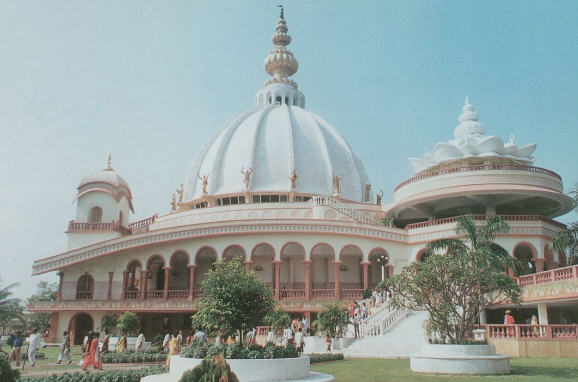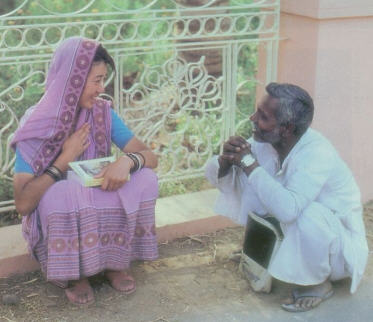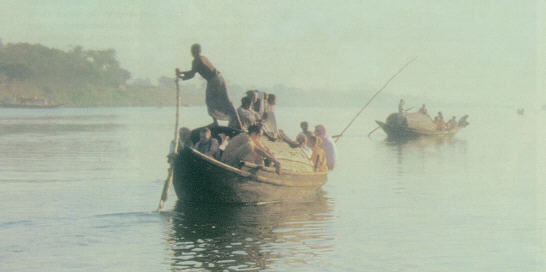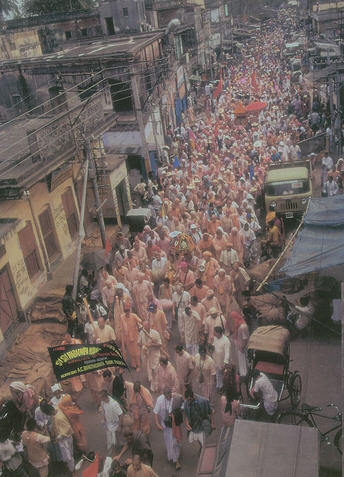"After a refreshing afternoon swim, we relax on the shore of the Ganga
and discuss pastimes of Lord Caitanya."
CAITANYA Mahaprabhu appeared to deliver divine love of Krsna to people all over the world, and Srila Prabhupada made Lord Caitanya's mission a reality for fortunate people like me. Although I am a neophyte still steeped in mundane vision, by the kindness of Srila Prabhupada and Lord Caitanya I have been able to spend much time in Sridham Mayapur, the birthplace of Lord Caitanya Himself. Here are some impressions from a recent pilgrimage.
Travel

Although I always love going back to Sridham Mayapur, I'm not looking forward to checking onto the airplane. My husband, Krsna Prema Dasa, and I are overloaded with equipment this year and expect to have to pay a hefty overweight charge. The limit is 23 kilos per person, giving us a total of 46 kilos. Our baggage weighed in at 75 kilos, and we don't expect the airline to look the other way.
As we walk to the check-in at the Copenhagen airport, an airline official waves us from the crowded queue at the coach counter to the vacant first-class counter. The woman at the counter doesn't bat an eye at our being so much overweight. We save about $500. I've heard that you can't buy a ticket to the holy dhama, that you can go there only by Krsna's mercy. I take the incident as a sign of Krsna's mercy and an auspicious start to our pilgrimage.
We arrive in Calcutta just twenty minutes behind schedule. Although we had arranged for a jeep, it never shows up. So we take one of the ubiquitous bright yellow Ambassador taxis, a '50s-style British sedan. After a half-hour ride through the grit and bustle of suburban Calcutta, we enter the lush, perfectly flat Bengali countryside. Meticulously attended rice paddies stretch to the horizon on both sides of the road. Aside from the screeching horns of the extravagantly painted lorries (trucks), it is a peaceful, if bumpy, three-hour ride north to Mayapur.
Driving the final and roughest stretch of road, we pass the house of Srinivasa Acarya, where Lord Caitanya began His sankirtana movement. We then pass the samadhis (memorial tombs) of Srila Bhaktisiddhanta Sarasvati and Gaura Kisora Dasa Babaji, great gurus in our line, and the birthplace of Sri Caitanya Mahaprabhu Himself. Its beautiful temple, built by the great Bhaktivisiddhanta Sarasvati (Srila Prabhupada's guru), stands tall above the flat countryside.
Finally we reach our destination: the ISKCON temple in Sridham Mayapur, the Mayapur Chandrodaya Mandir, founded by our beloved guru, Srila Prabhupada. After climbing from the cramped cab, we reverentially bow our heads to the ground, in the dust of the holy dhama.
A Peaceful Life
Several hundred devotees representing all the continents live in the ISKCON Mayapur complex, which covers many acres. A palpable, benevolent spiritual atmosphere and a simple way of life attract them to visit and stay. We make our way to our second-story flat in the grhastha (householder) colony, where some fifty families live in a variety of private homes and apartment buildings.

I love ISKCON Mayapur. From our flat you can take a short and healthy walk or bike ride to the beautiful temple of Sri Sri Radha-Madhava. Every day Their Lordships and Their eight attendant gopis (cowherd girls) sport beautiful outfits in endless varieties of colors and patterns. Before separate altars in the huge temple one can pray to Lord Nrsimhadeva (Lord Krsna's half-man, half-lion incarnation) and Sri Panca-tattva (Lord Caitanya in five forms). A murti (carved form) of Srila Prabhupada surveys the entire temple room from a marble vyasasana (the seat of the guru). On the way back to my flat I often visit Srila Prabhupada's Samadhi, its graceful 180-foot dome surrounded by elevated walkways, parks, and a lake.
Elsewhere on the Mayapur property one finds schools for young and older children as well as a research institute for Vaisnava studies. A huge kitchen area feeds thousands of guests. Shops and stalls selling beads, Deities, and other devotional necessities line the inner and outer walls of the compound. Doctors run both allopathic and Ayurvedic clinics, and the devotees operate a free ambulance service, the only one available to the people of the surrounding villages. Parks, snack bars, guest houses, and other facilities await the thousands of pilgrims who enter daily up to fifteen thousand on weekends. Behind the temple stand two four-story ashrams accommodating the hundreds of young men training as Vaisnava monks (brahmacaris). Beyond the guest houses lies the Bhaktivedanta Book Trust complex, where devotees publish hundreds of thousands of Prabhupada's books, sold by the brahmacaris throughout Bengal.
Since Krsna Prema and I have portable occupations (and no children), we often travel back and forth between Mayapur and the West. This time we'd been gone for six months. Over the next week I went through all the cabinets, cleaning and washing and discarding old things no longer needed.
After a stint in the hectic West, the simple Mayapur life refreshes the spirit. Uttam brings fresh milk to our door every morning, as he has for the past few years. He rides a bike with metal cans filled with milk and straw on either side of the back wheel. The straw keeps the milk from splashing out. Milk costs eleven rupees a liter about twenty-five U.S. cents. Each day I boil one liter, make it into fresh curd, press it into a flat round patty, salt it, and put it into our small refrigerator for use in salads and vegetable dishes.
Tomatoes and greens come from our neighbors' gardens, along with lots of basil. We either buy other vegetables at the local market or pay Arun from the neighboring village to go across the river and get our supplies. Our maid, Gauri, appears most days to wash the laundry and the floor. During this dry part of the year, the dusty air makes her services essential. She has many other houses on her list as well.
The Ganga

The wide and powerful Ganga (Ganges) takes a long, sweeping turn to come within a few hundred feet of ISKCON Mayapur. This most sacred river originates from the lotus feet of Lord Visnu, then flows from the Himalayas across northern India, past Mayapur, and through Calcutta to the Bay of Bengal. To bathe in her cool, sacred waters cleanses the soul of past sins.
Almost every afternoon we bathe in the Ganga. The weather is hot, ranging from 75F at night to 100 or more during the day, with high humidity. A refreshing afternoon swim is perfect. For the past few years we've gone to a nearby sandy shoal. This year it's gone, washed away in last year's rainy-season floods. So we go upriver to a set of steps built by ISKCON, leading to a calm inlet. To keep our towels dry we take a one-rupee boatride across the inlet and walk across another shoal to the river. Here the Ganga flows swiftly and eats away at the earth. All across this 200-yard sandbar it's at least a four-foot drop to the water. Once you're in, the water becomes deep very quickly, and you have to be careful.
Clay lines the banks of the Ganga, with a creamy consistency that makes a great mudpack. We relax on the shore and discuss pastimes of Lord Caitanya. The gentle breeze and cooling waters of the mighty river offer welcome relief from the heat.
Storm Season
Spring brings strong and sudden showers from dark, thundering clouds. In this part of West Bengal high, cool winds accompany the storms. The rainy season has now arrived. It cools us down and wets the land. This year everyone welcomes the rain, as there has been none since October. The high winds knock down trees and sometimes blow away huts. Just before the rain, winds blow in sand from the Ganga's banks.
Usually the storms roll in during the afternoon, though they come at other times as well. We keep a watchful eye on the sky, especially the northwest. Monsoon rains usually come from the southeast and bring no wind. A very dark cloud mass lets us know that a storm is on its way. The storms move fast, so when we see one we hurry home and close all the windows. If we are going out on a pilgrimage, we carefully secure our flat so the dust doesn't blow in everywhere.
Sometimes a storm springs up while we're in the Ganga. When that happens, we stay in the water near the edge instead of getting pelted by flying sand. The cool and sometimes icy-cold blasts of wind can be really refreshing in the heat. Our neighbors, a couple from Russia, often go out and sit on a bench to take the refreshing rains.
When the storms come at night, we wake up suddenly and have to scramble to close all the windows. If it's too late and the winds are upon us, we're better off leaving the windows open, because closing them in the wind is really tough. With all the windows closed we wait and listen to the wind and thunder, sometimes venturing to the roof to catch the cool wind and water. Then when the storm tails off, we open the southerly doors and windows and let the cool breeze refresh the house.
Calcutta
Spiritual life should be as simple as possible. Yet Lord Caitanya's great disciple Rupa Gosvami also taught the principle of yukta-vairagya using everything in the service of the Lord. Krsna Prema and I find ourselves needing computer equipment for our devotional service. So we ride back to Calcutta to buy a computer monitor and a power backup for continuous operation when storms knock out the current. (This happens fairly often, although ISKCON Mayapur does have its own backup generators.) We've done our research and lined up two stores that stock these items. We encounter no problems, although when it takes half an hour to get a receipt, I feel like a harried, rushed Westerner.
Once the capital of British India, Calcutta retains a Victorian stateliness, under a thick veneer of smog, dirt, and urban chaos. While riding through the crowded streets, I remember that Srila Prabhupada was born here and began his journey West from here. But for his journey, I would have never come to the land of Lord Caitanya.
On the way back to Mayapur we notice the simple Indian way of doing modern work with human labor. Some road workers are extending the subway system and reinforcing the sides of a deep pit with long wooden piles. After rigging a tripod with bamboo poles, they sling a rope and a pulley over the top. Three men hoist and drop a huge steel flat-ended weight, driving the 25-foot piles into the ground. It seems to work without a hitch.
On the way back we pull in to New Market, an old but air-conditioned indoor market offering endless shops with everything from clothing to calculators. We stop for fruits and vegetables. Bengal has some interesting varieties. One fruit looks like a white pear, but is crunchy and full of fresh water. It has little taste but quenches the thirst. The rose-apple is a small round green fruit with a big ball of a seed. It's crunchy with a delicate sweet rose flavor. We offer some fruits to Lord Krsna and then enjoy them asprasadam.
Residents Of The Dhama
Although I'm from the West and materially privileged by comparison, I feel humbled by the natural devotion and spirituality of the residents of Mayapur. At the temple's 4:30 A.M. mangala-arati ceremony, one often sees dozens or even hundreds of local residents who have risen hours earlier and walked a great distance to attend. On the weekends tens of thousands of pilgrims flock to ISKCON Mayapur to take the blessings of Sri Sri Radha-Madhava and Srila Prabhupada.
Sri Caitanya Mahaprabhu Himself spoke Bengali, and many important scriptures appear in the classical version of this pleasing and lilting tongue. Through tapes or live chanting, throughout Sridham Mayapur one constantly hears the divinely beautiful sound of Bengali bhajanas (devotional songs). Chanting Lord Krsna's holy names seems to come so naturally to these fortunate souls. I feel purified in their association.
It is said that one should see all residents of the holy dhama as associates of the Lord, even the animals. Many diverse creatures reside in Mayapur. Large silvery monkeys, with black faces, hands, feet, and tails, appear here and there, although they are much less numerous here than in other parts of India. They look part human, part Siamese cat, as they gracefully jump from tree to tree, scramble up the sides of buildings, or run along the ground. A large family of these monkeys visits every morning. Some of the devotees feed them, although sometimes they become mischievous, making a mess out of a garden or a load of laundry on a clothesline.
Last year in Vrndavana a small monkey jumped on my shoulder and snatched the glasses off my face. He darted up a wall and began chewing on them. A local boatman bribed the monkey with sweets to get back the glasses, badly chewed but usable. Fortunately, the monkeys in Mayapur are neither so mercenary nor small enough to jump on your shoulder.
Many types of birds reside in Mayapur. Beautiful white cranes wade in the river or in the flooded rice fields. Parrots fly by in chattering groups, and throughout the day one hears doves coo. I cannot identify the many other colorful birds, including the one who perches in a tree near our window every morning singing his song. This little fellow serves as our alarm clock. His tune is a three-note-up-and-down doo dah doo. With each set of the notes he ups the pitch until it's extremely high. In the evening he cannot go so high. I suppose he is hot and tired from the day's activities.
ISKCON Mayapur keeps a deer park with about ten deer. The bucks have remarkably long horns. Walking past them through the central park one reaches the elephant shed. ISKCON Mayapur's elephant is named Gulab, meaning "rose." She's an Indian elephant, much smaller and gentler than the African variety. She loves bananas and sweets. She also loves chest rubs.
Every Saturday night Gulab's keeper adorns her with paint, ornaments, and a fancy cloth. She then loads several priests and the processional Deities from the temple on her back for a one-hour walk around the Mayapur compound. During frequent stops devotees bring offerings to the Deities. Gulab then takes the prasadam with her trunk and majestically strides on.
The deer and the elephant provide beauty and entertainment for the pilgrims in Mayapur. On a more practical side are the cows and bulls. ISKCON Mayapur maintains a goshalla, a bovine sanctuary, with numerous milking cows and working bulls as well as young and retired animals. Local farmers use either bulls or water buffaloes to till the fields for wheat and vegetables and to prepare the watery patches for planting rice. On hot afternoons at the Ganga you often see farmers herd their buffaloes or bulls for a refreshing bath.
Many types of Indian cows differ sharply from those in the West. Unfortunately many of these indigenous species have been crossed with Western breeds to increase milk, usually unsuccessfully. Thus many types are becoming rare or even extinct. Brahma bulls have a large hump behind their head and long, floppy ears. Sometimes I see a white pair of tall Brahma bulls looking majestic as they pull a gurney along the road.
In the western Indian state of Gujarat, bulls have massive, gradually tapering horns that curve out, then in, then out again at the top. Their shape resembles a vase. For several years two such Gujarati bulls pulled Deities of Lord Caitanya and Lord Nityananda on a walking kirtana procession, or padayatra, for tens of thousands of kilometers throughout India. They concluded their extraordinary journey in Mayapur in 1986. A stone memorial marks the event, and it has become a favorite chanting site for pilgrims.

Other animals abound in Mayapur, such as dolphins in the Ganga, unique and colorful lizards, and, yes, even some cobras and vipers. Though I have never seen one, such serpents are said to come out in the evenings. The other day Krsna Prema saw two cobras dancing. For some time they sat facing each other in the grass, rising up, intertwining, then separating and slinking back into the grass. He recalled Lord Caitanya's childhood pastime of horrifying His parents by playing with a cobra in His courtyard. The cobra turned out to be Ananta Sesa, the Lord's divine serpentine associate. The pastime reminded us that no creature in the holy dhama is ordinary.
According to a neighbor who claims to have seen it first hand, our gardener knows the art of extracting poison from a snakebite. As far as I know, such bites have never occurred on ISKCON Mayapur's land, but I shudder to think of myself in need of the gardener's skill. I calm my jitters by recalling the Bhagavad-gita's instructions about the temporary nature of the material body and the auspicious benefit of leaving this world in the holy dhama.
Lord Caitanya's appearance day, known as Gaura Purnima, comes on the full-moon day of the month of Phalguna, in late winter or early spring. The government erects a tent city to accommodate the hundreds of thousands of pilgrims who flock to Mayapur for this auspicious day, most of them visiting ISKCON Mayapur. After the early-morning service, attending the temple on this day is virtually impossible. Never have I seen such an enormous crowd. Krsna Prema and I spend the day peacefully chanting in our flat and watching the rising full moon from the rooftop.
Packed with our equipment and with gifts, and with incense for the Deities, we prepare to return to the West, perhaps even heavier than when we arrived. On our last evening I look at Srila Prabhupada's towering samadhi dome, encircled by a ring of ten-foot metal sculptures of devotees in kirtana. This calls to mind Srila Prabhupada's determined effort to establish ISKCON Mayapur as a place of pilgrimage for devotees of Krsna from all over the world. We come here to gain spiritual strength, and we return to our native lands to give Krsna consciousness to others.
To strengthen us, and to make a place large enough for ten thousand devotees to gather at once in congregational chanting, in 1977 Srila Prabhupada laid the cornerstone for the Temple of the Vedic Planetarium. Over the next few years, this magnificent temple, one of the largest religious structures on earth, will rise from the Ganga plain as brilliantly as the red morning sun rises from the smooth Mayapur horizon.
As we drive out, I recall that once you come to the holy dhama, you never leave. You simply carry it elsewhere in your heart.
Nitya-trpta Devi Dasi, a photographer, and Krsna Prema Dasa, a musician, created Krsna Vision, a multi-slideprojector presentation. Now they're moving more into the digital realm, developing CD-ROMs and computer presentations.
